8 December, 2003
The Pump Station
While there are eleven members of the Erebus team, there are actually
several individual projects being conducted concurrently this season.
Shauna Mikelich, a graduate student at New Mexico Tech, is sampling
volcanic gas for aerosols, tiny invisible parcticles. I accompanied her
today on her sampling trip up to the crater rim.
Before leaving for the rim, Dr. Philip Kyle, the Principal Investigator
on the Erebus project and Shauna’s advisor, showed her how to assemble
the filter packs used in this project (Figures 1 and 2). The filter
packs consist of three filters separated by plastic sleeves sealed with
o-rings. The top filter is untreated and it catches any solid parcticles
that are larger than 2 microns. The next two filters in the series are
treated with lithium hydroxide (a base) which traps any acidic gasses.
The third filter is used to catch any material that makes it past the
first two (Figure 3).
After the filters were assembled, we rode the Skidoos part way up to the
crater rim. The route we travel to get to the pump site is twisty,
steep, and rocky. As we have eleven people and only six Skidoos, we
often have to ride double. As it happened, this was my turn to ride on
the back of one of the big Scandic Skidoos. As Harry, the driver,
floored the snowmobile up a path aptly named the “Rock Garden,” I flew
off right off the back and landed square on my stomach. Ouch! This was
my first spill off of a snowmobile and, as I trudged up the slope to
catch up to Harry who didn’t realize I was gone, I hoped it would be my
last. I had no such luck as, on the final turn, we flipped the Skidoo
over. Pushing against the overturned machine I started thinking that
walking just might be preferable.
Safely on my own two feet again, I started the seemingly endless climb
to the pump site. Relieved to find that the climb was easier than
yesterday, I searched for crystals on the way up. After a quick breather
at the top and another admiring glance into the cloudless crater, we got
to work. We gassed up the generator, attached the batteries, and then
hooked up the pumps that would draw the plume air through the filters
(Figure 4). We attached the filter packs to a rack overhanging the
crater rim (Figure 5), recorded environmental information (Figures 6 and
7) and flipped the “on” switch. For the next 90 minutes we were free to
wander around and see the sights.
One attraction from the rim was watching part of our team attempt to
reach the inner crater (Figure 8). The last attempt was in 1978 and it
was foiled by an eruption of lava bombs. Dr. Harry Keys (Figure 9), from
New Zealand, and Peter Kelly (Figure 10) rappelled down the main crater
wall and, using crampons, traversed to the inner crater. At about 9 PM,
they became the first people to stand at the edge of Erebus’s lava lake!
Quite an exciting accomplishment!
As our colleagues were descending to the lava lake, we finished pumping.
With numb fingers, we disassembled the pumps and stored the filter packs
in plastic bags. Before descending to the Skidoos, I unfurled the St.
John’s School pennant at the top of Mt. Erebus. Narrowly missing a gust
of wind that could have incinerated the flag in the lava lake, we
managed to take one photo before the camera batteries died from the
cold. Taking our cue from the camera, we headed back to the warmth of
the Lower Erebus Hut and dinner.
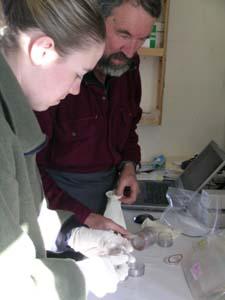
1. Figure 1 – Dr. Philip Kyle, the Principal Investigator on the Erebus project, teaches graduate student Shauna Mikelich how to load the filter packs for her gas-sampling project.
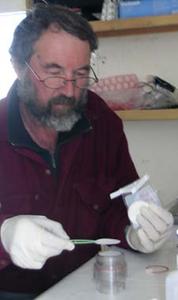
2. Figure 2 – A clean space is important in preparing filter packs. The packs are being used to filter heavy metals and lead vapors from the plume. In loading the filters into the holders, care is taken to avoid cross-contaminating them with outside sources of metals.
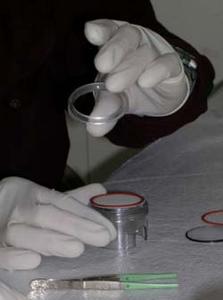
3. Figure 3 – The filter packs are loaded with three filters, separated by sleeves fitted with o-rings. All components of the filter packs were cleaned with alcohol before loading and tweezers are used to handle the individual filters.
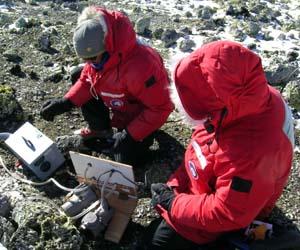
4. Figure 4 – Peter Kelly and Shauna Mikelich examine the pump system used to draw the plume air through the filters. The pumping station is located on the northwest side of the crater rim.
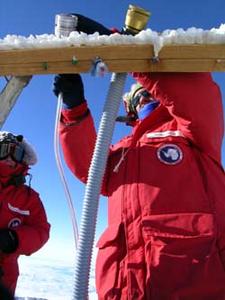
5. Figure 5 – Peter demonstrates how to attach the filter packs to the rack, which suspends the filters near the edge of the crater rim. The tubes lead down to the pumps shown in Fig. 4.

6. Figure 6 – Care is taken to record all pertinent information such as wind speed and direction, size of plume, location of filters on the rack, pump volume, etc.
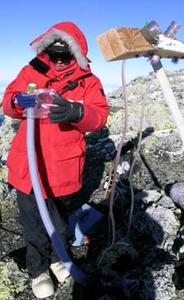
7. Figure 7 – After 90 minutes of pumping, cold fingers made it challenging to remove the filter packs and reseal them in plastic bags.
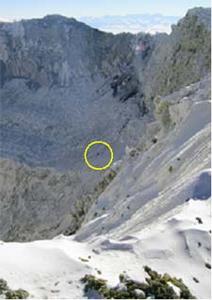
8. Figure 8 – At the same time we were pumping gas from the plume, two other members of the team, Dr. Harry Keys and Peter Kelly, were rappelling down into the inner crater (yellow circle). An hour later they reached the edge of the lava lake, the first people to successfully enter the inner crater and reach the lake. There have been no other attempts since 1978.
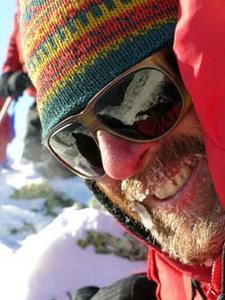
9. Figure 9 – Harry Keys, one of the two lava lake team members, exhibits how the Antarctic cold affects the body. Mustaches freeze breath into interesting ice formations.

10. Figure 10 – Peter Kelly, the other lava lake team member plays a quick game of volcano baseball with Julie Calkins atop Mt. Erebus.
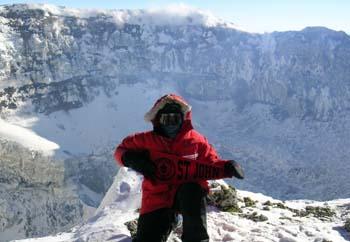
11. Figure 11 – While it blends well with my big red parka, the St. John’s School pennant accompanied me to the top of Erebus. At one point the wind was strong enough to blow it right out of my gloved hands. Fortunately the wind was coming from behind me, or else the pennant would have been blown into the crater as a sacrifice to the volcano.
Contact the TEA in the field at
.
If you cannot connect through your browser, copy the
TEA's e-mail address in the "To:" line of
your favorite e-mail package.
|
